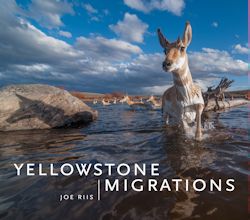SEJournal Online is the digital news magazine of the Society of Environmental Journalists. Learn more about SEJournal Online, including submission, subscription and advertising information.
BookShelf
“Yellowstone Migrations”
Photographs by Joe Riis; Contributions by Arthur Middleton, Emilene Ostlind, Gretel Ehrlich and Thomas Lovejoy
Mountaineers Books, $29.95
Reviewed by Eliza Murphy
Even before cracking open this book, its heart comes into focus.
Gem-like droplets splash off a pronghorn’s foreleg. She is focused on the bank, where instead of a predator lurking, a camera records the herd as it crosses the river behind her. Even her shadow, cast on a boulder, is alert. A storm gathers in the distance. Rendered with striking clarity, the image captures awe and a foreboding situation.
Pronghorn ought to grace the cover because they sparked an artistic and scientific odyssey that resulted in the discovery of the longest migrations of terrestrial animals in the Lower 48 states.
 |
Curious about animal migrations from childhood, author-photographer Joe Riis was instantly captivated by pronghorn migrations after he learned about them from journalist Emilene Ostlind.
Riis, a trained wildlife biologist who taught himself cinematography, knew after the first trip he took to document the pronghorn’s migration that taking fine pictures of the animals was an insufficient response to an ancient migration imperiled by human encroachment.
In “A New Vision for Yellowstone,” Ostlind’s essay for the volume, she observed that Riis “needed the scientists to show him the skeleton of the migration, and the scientists needed Joe’s photos to put flesh on the bones.”
Riis teamed up with wildlife biologists Hall Sawyer and Arthur Middleton to gather evidence of the mythical journeys taken by pronghorn, mule deer and elk through the Greater Yellowstone Ecosystem, a complex mix of public and private land.
Until Riis and his team of wildlife biologists ventured into some of the most remote places in the continental United States, folks familiar with the remote backcountry extending beyond the boundaries of Yellowstone National Park had only an inkling of the grand journeys undertaken by ungulates.
Advances in wildlife surveillance technology enabled researchers to plot well-established paths ungulates have taken for at least the past 7,000 years.
Riis is a masterful photographer with an intimate knowledge of animal behavior. He took extensive precautions to recede into the background to avoid influencing them by his presence. These are not the usual blurry images caught on motion-detecting wildlife cameras, but ravishing photographs that frame ungulates captured en route between winter and summer ranges.
The photographs also provide evidence that these ancient pathways are under threat from the fossil fuel industry and subdivisions. Stark images highlight the predicament we’ve imposed on wildlife: mule deer cross a road that severs their migration route, a pair of pronghorn stand near an oil drilling rig and a lone pronghorn stands helpless in the snow, his rear leg trapped in barbed wire.
“The photographs provide evidence that
these ancient pathways are under threat
from the fossil fuel industry and subdivisions.”
Jagged lines superimposed on land use maps show the routes animals have used for eons, highlighting troublesome spots where migration is threatened by rapid growth from a surge in the fossil fuel industry and its attendant development.
The book’s collection of essays further illuminates the complexity of a dynamic narrative unfolding in the interior American West.
Ostlind’s immersion in the field with Riis and his team gave her unique insights into the exciting story about the discoveries they made, as well as the current tension over land use, especially public land protection.
“Even as the system appears strong and protected, it is crumbling at the edges,” Ostlind observes. Animals don’t honor static lines drawn on maps: The photos in this book show them moving through the entire landscape. The park may have been a brilliant idea, but conservation must expand to protect animal pathways.
“We can’t just draw another rectangle and set it aside for wildlife” Ostlind notes. “We need a new way of interacting with the landscape, a way to start knitting our own existence more closely with the other species that also rely on these lands for survival.”
Researchers provide solutions, such as wildlife crossings that guide pronghorn safely away from burdensome winter ranges. They’re diplomatic when attempting to bridge political boundaries and personal differences to ensure animals can continue to traverse across terrain fraught with human conflict and risk.
Filled with both wonder and warning, this book is a fine example of merging disciplines to tell a multi-layered and inclusive story. Through a fine balance of show and tell, Riis supports his introductory declaration: “Without migration, abundance declines and wilderness disappears.”
Eliza Murphy is an Oregon-based freelance writer and SEJ member.
* From the weekly news magazine SEJournal Online, Vol. 3, No. 9. Content from each new issue of SEJournal Online is available to the public via the SEJournal Online main page. Subscribe to the e-newsletter here. And see past issues of the SEJournal archived here.













 Advertisement
Advertisement 



